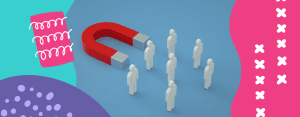Turning leads into loyal customers is the common goal shared by companies of all sizes and sectors. To achieve that, marketers have perfected techniques to attract, convert, and potentially delight customers.
On that matter, few methodologies are as successful as the one known as Inbound Marketing.
The central idea is to offer valuable content and personalized experiences to the audience, creating a positive relationship with the brand.
To do that, a company has to apply the concept of the customer lifecycle journey, which aims to follow the steps taken by a customer as they progress through the marketing and sales funnel.
That allows your company to focus on activities that will directly impact the conversion rate for each stage, maximizing the ROI.
In this post, we will explain, step by step, how the customer lifecycle journey works, and the role that marketing plays in each stage.
We will also talk about how interactive tools can be used to optimize the process. Keep on reading!
What are the stages of the customer lifecycle journey?
Understanding what factors influence a client’s buying decision has been key to marketing success for a long time now.
When professor and marketing guru Philip Kotler defined the idea of customer 4.0, he made clear that to be competitive in the digital era, a company had to provide an excellent buyer’s journey to its public.
If you excel in that goal, you’ll see your base of clients transform into brand advocates, which is the last of five stages of the customer lifecycle journey. Next, we’ll explain each one of them.
Discovery
The discovery phase, also known as “awareness,” is when the person begins searching for a solution, officially initiating the customer lifecycle journey.
At this point, they’ll compare different products, read reviews, and consume informative content. They understand there is a problem to solve but are not always sure what it is.
To learn more about it, the audience turns to different channels of information, such as blogs, social media, and search tools.
If you have a robust digital marketing strategy, this is the moment when they’ll discover your brand. When that happens, the next stage begins.
Education
After making the first contact with your company, the prospect enters the second stage of the journey: education. The brand will respond to the customer’s concerns, as well as to inquire for more information about their needs and motivations.
That knowledge will allow the company to offer the most appropriate content on the subject, assuming a position of market authority.
The idea is to create a relationship of trust, treating the customer as something more than just another business opportunity. As we discussed, that kind of effort is critical in the process of turning a visitor into an actual client.
When properly educated on their problem, the buyer will be ready to make a buying decision.
Conversion
The third stage is marked by the conversion of the lead into a consumer. If it has reached this point, the prospect has already sought information about the problem and decided that your solution was the most reliable one.
Here, it is vital to keep the focus on building a lasting relationship instead of forcing a sale. Such a decision should come from the lead.
This more consultative approach is a fundamental element to enable the development of the next stage of the journey.
After all, while valuing companies that act as partners, the modern consumer loses interest when they notice that the brand does not appreciate their experience.
Retention
After converting the lead, your goal is to keep them in your consumer base and enable them to make more purchases in the future.
In a market as competitive as today’s, in which the public has several alternatives, achieving this goal is essential to ensure business sustainability.
Making a follow-up contact is an excellent way to demonstrate that, although the transaction is done, you are still there for when the customer needs you.
Naturally, it would be best if you had a complete strategy in this regard, especially with the production of engaging content and the use of social networks. We’ll talk more about this later.
Advocacy
The last stage of the journey is only achieved if the customer feels valued by the brand and delights with the experience provided.
More than a loyal buyer, the consumer becomes a brand advocate, organically promoting it in their social networks and other channels.
Having a brand ambassador is hugely positive in the process of acquiring new clients. That’s because, as observed by several scholars, the current public pays much more attention to the opinion of friends and influencers than to great advertising efforts.
What are the lifecycle marketing activities?
As important as understanding what the customer lifecycle journey is, it is mastering the marketing activities that can be useful throughout the process.
After all, taking a proactive and strategic approach is critical to enabling all the steps we’ve already discussed, starting with discovery. Below, we’ll list practices relevant to all phases of the journey.
Identify the target audience
Indeed, a digital marketing strategy usually takes a more subtle approach, waiting for the customer to find the brand organically.
This movement is only possible, however, if the company knows exactly who it wants to reach. Therefore, defining a target audience is a must.
By establishing a specific audience, you make your efforts more effective, as they will exclude individuals who do not fit the pre-defined characteristics.
If you target your product to a particular age group, for example, you can focus your efforts on communicating with it.
To further optimize the strategy, many brands invest in the creation of a persona, i.e., a semi-fictional character that represents the ideal customer.
Besides demographic data, the persona has more abstract features, such as motivations, pains, and interests.
Produce qualified content
After defining the persona, the marketing team can start producing relevant content, suitable for the characteristics of the target audience.
At this point, it is essential to consider factors such as the language and channels used to encourage audience engagement.
It is also crucial to pay attention to which stage of the journey the content seeks to impact. Blog and social media posts are excellent ways to attract new visitors, especially if combined with efficient SEO practices, such as the use of keywords and link building.
If the goal is to deal with leads that are already in the conversion phase, for example, using advanced materials such as e-books and whitepaper may be the best alternative.
In all cases, producing educational content should remain a constant activity, consolidating the brand as an authority on the subject.
Facilitating the consumer experience
The internet is supposed to be a place where people perform their activities simply and quickly. That’s why it’s your company’s role to ensure that the customer lifecycle journey follows these characteristics.
Mobile-friendly pages, qualified service, and transparency are some of the factors that are influential in this regard.
Here, we need to talk about the increasing use of interactive content as a facilitator of this experience. A recent survey indicated that 90% of marketers consider this type of resource very useful in educating the consumer.
More than that, interactivity creates a much more satisfying journey.
The use of quizzes, for example, encourages visitor engagement and also generates valuable data and insights for the company.
Other tools, such as calculators, can be instrumental in informing the consumer about the benefits they can achieve when closing a deal. We’ll come back to that later.
Customize the post-purchase engagement process
As we talked about in the second topic, it is necessary to maintain contact with the consumer even after the sale closes. It’s the marketing department’s job to establish a personalized onboarding, paving the way for the loyalty process.
Configure a bot to give thanks right after the purchase or, if possible, contact them directly.
Encourage brand advocacy
Many clients need a little push to act as brand lawyers. So don’t hesitate to encourage sharing a post or even leaving a review on sites like Yelp or Google Reviews.
Including calls to action inciting this kind of engagement is a great way to optimize your organic reach.
Depending on the case, you can develop reward programs, awarding your customers according to their loyalty to the brand.
It is also valid to offer discounts and benefits for specific actions, such as referring your product to friends and family.
The strategic use of interactive tools has the power to facilitate the consumer’s journey and lead them towards conversion.
The reason is that, by encouraging interaction, you create a distinct and engaging experience, making the customer more likely to do business.
A very well-known example is the interactive calculators, generally used to demonstrate the advantages that a customer can achieve by engaging with the brand.
Take as an example this calculator created by Ion Interactive for Symantec, a company specialized in cybersecurity.
When accessing the tool, the visitor can calculate what their ROI would be if they decided to invest in the service.
Besides demonstrating the company’s commitment to transparency, the calculation ends up becoming a convincing factor for the person to make the purchase.
The use of interactive tools optimizes all the stages of the consumer’s journey.
These resources are designed to attract and retain the lead’s attention, bringing them closer to a profitable relationship with your company.
Understanding the customer lifecycle journey is fundamental for the development of an efficient marketing strategy.
You must pay attention to the different stages and use the best techniques to enhance the customer experience. In this sense, using interactive tools can prove to be quite a differential.
Ready to excel in communicating with your potential customers? How about continuing learning? In this post, we explain how to create content that resonates with your audience. Take a look!







